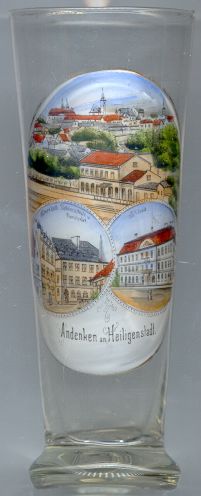

|
| DEUTSCHLAND | GERMANY |
| Bundesland: Freistaat Thüringen | Thuringia |
| Landkreis: Eichsfeld |
 Heilbad Heiligenstadt is situated at an elevation of 260 m in the headwater valley of the river Leine in northern Thuringia.
Mentioned for the first time in a document in 973, Heiligenstat became in possession of the archbishops of Mainz
some time between 990 and 1023 and later became a centre of the Eichsfeld region. Heiligenstadt was chartered
as a town in 1227. Until 1803, Heiligenstadt and the Eichsfeld remained part of the Electorate of Mainz.
After the Peace of Lunéville of 1801 and the secularisation of 1803, the Eichsfeld became part of Prussia (province Saxony).
During the Napoleonic Wars, Heiligenstadt became French in 1806 and was incorporated into the Kingdom of Westphalia in 1807
where it remained until 1813. After the Congress of Vienna (1815), the Eichsfeld was divided between
Prussia and the Kingdom of Hannover; Heiligenstadt became Prussian again. The town luckily suffered
only little damage during World War II and could retain most of its old Gothic churches, Baroque buildings and half-timbered houses.
Since 1994, Heilbad Heiligenstadt is the capital of the disctrict Eichsfeld.
Heilbad Heiligenstadt is situated at an elevation of 260 m in the headwater valley of the river Leine in northern Thuringia.
Mentioned for the first time in a document in 973, Heiligenstat became in possession of the archbishops of Mainz
some time between 990 and 1023 and later became a centre of the Eichsfeld region. Heiligenstadt was chartered
as a town in 1227. Until 1803, Heiligenstadt and the Eichsfeld remained part of the Electorate of Mainz.
After the Peace of Lunéville of 1801 and the secularisation of 1803, the Eichsfeld became part of Prussia (province Saxony).
During the Napoleonic Wars, Heiligenstadt became French in 1806 and was incorporated into the Kingdom of Westphalia in 1807
where it remained until 1813. After the Congress of Vienna (1815), the Eichsfeld was divided between
Prussia and the Kingdom of Hannover; Heiligenstadt became Prussian again. The town luckily suffered
only little damage during World War II and could retain most of its old Gothic churches, Baroque buildings and half-timbered houses.
Since 1994, Heilbad Heiligenstadt is the capital of the disctrict Eichsfeld.
The tradition of Heiligenstadt as a spa town becan in 1929 when the first facilities for cold water cures were opened. In 1950 the name of the town was officially changed to Heilbad Heiligenstadt.
The  former Jesuit college [bottom left] was built in 1739. Later it served as a
gramar school for girls (on the glass, the building is labelled as 'höhere katholische Töchterschule'). Today it houses Heiligenstadt's
museum of local history.
former Jesuit college [bottom left] was built in 1739. Later it served as a
gramar school for girls (on the glass, the building is labelled as 'höhere katholische Töchterschule'). Today it houses Heiligenstadt's
museum of local history.
The  Schloss (castle) [bottom right] was built in 1736–1738 in Baroque style
as the seat of the ethnarchy (Statthalterei) of the archbishop electors of Mainz. Today it is used by the administration of the
district Eichsfeld.
Schloss (castle) [bottom right] was built in 1736–1738 in Baroque style
as the seat of the ethnarchy (Statthalterei) of the archbishop electors of Mainz. Today it is used by the administration of the
district Eichsfeld.
The famous sculptor and carver Tilman Riemenschneider (ca.1460–1531) was born in Heiligenstadt. After 1488 he worked in Würzburg.
The brothers Jakob and Wilhelm Grimm finalised the compilation of their 'Deutsches Wörterbuch' (German dictionary) here in 1838.
The important German poet and writer Theodor Storm (1817–1888) worked as a district judge at Heiligenstadt between 1856 and 1864. His office as a judge was located in the former castle [bottom right on glass no. 1421].
The famous German poet Heinrich Heine (1797–1856), born Jewish, let himself be baptized here to become Protestant in 1825.
![[scale]](lineal.jpg)